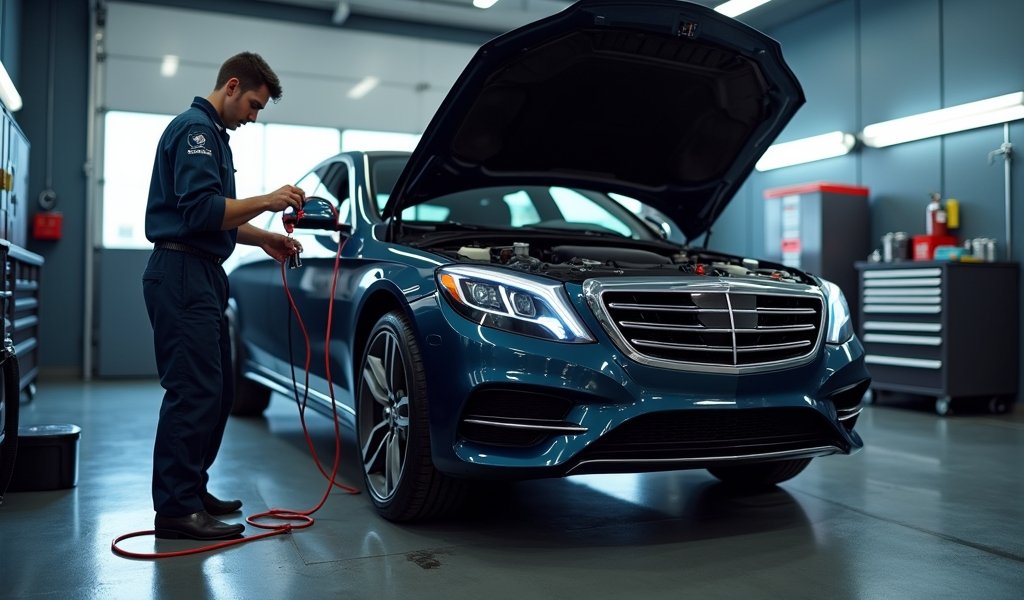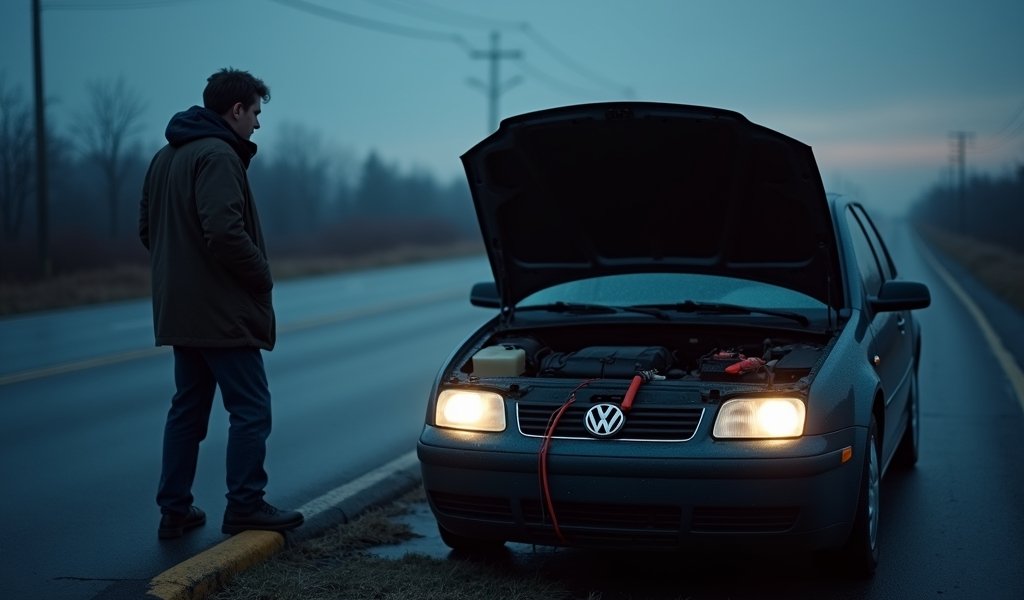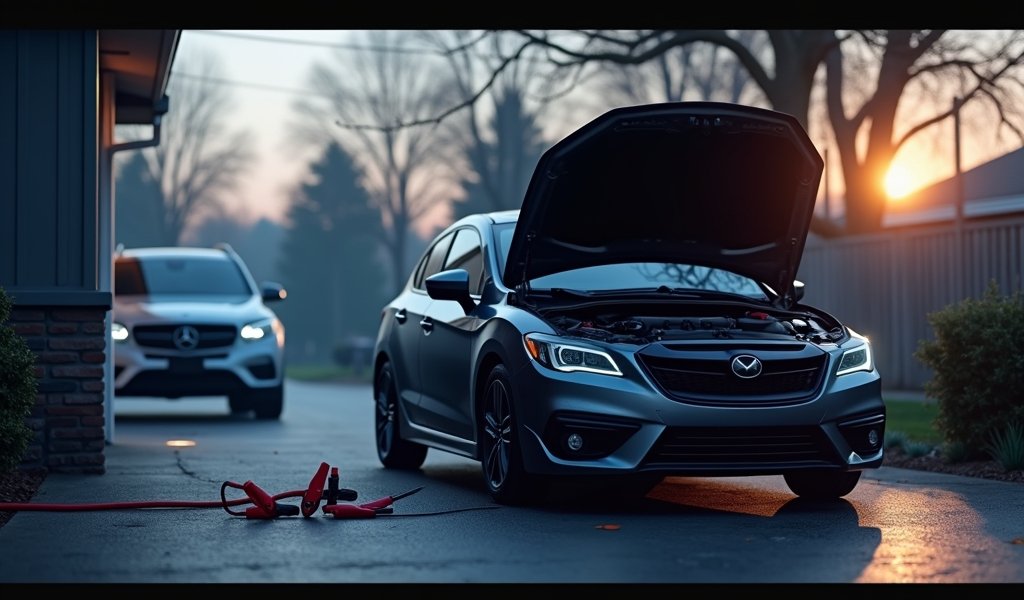Overview
This article provides a detailed, step-by-step guide to safely jump start a car, covering proper vehicle positioning, cable connection sequence, starting procedures, and disconnection methods. The guide emphasizes safety precautions throughout the process while offering additional tips on battery maintenance, warning signs of deeper issues, and preventative measures to avoid future battery drain.
Table of Contents
- Why Every Driver Should Know How to Jump Start a Car
- What You’ll Need for a Successful Jump Start
- Step 1: Position the Vehicles and Prepare
- Step 2: Connect the Jumper Cables Correctly
- Step 3: Start the Working Vehicle
- Step 4: Attempt to Start the Dead Car
- Step 5: Disconnect Safely
- Additional Tips and Precautions
- Conclusion
- Frequently Asked Questions
There’s nothing quite like that sinking feeling when you turn your key and hear nothing but a click. We’ve all been there – whether it’s a frosty winter morning, after leaving lights on overnight, or simply because your battery decided today was the day to give up. Knowing how to jump start a car is an essential skill that can save you time, money, and the stress of being stranded in an inconvenient place.
As a certified mechanic with 15 years of experience, I’ve jump-started hundreds of vehicles in all sorts of conditions. The good news? It’s actually quite simple once you know the proper steps. This guide will walk you through everything you need to know about safely bringing your car back to life when that battery decides to take a nap.
Why Every Driver Should Know How to Jump Start a Car
Dead batteries don’t check your calendar before quitting. They happen at the worst possible moments – when you’re running late for that important meeting, when you’re parked in a remote area, or when roadside assistance quotes a two-hour wait time.
Having this knowledge tucked in your back pocket is like carrying a tiny mechanic with you everywhere. It’s part of becoming a self-reliant driver who can handle common car issues without panic or excessive expense.
Beyond the convenience factor, jump starting a car safely requires understanding the potential risks involved. Car batteries contain sulfuric acid and can produce hydrogen gas – a combination that demands respect. Doing it wrong can damage vehicle electronics, cause personal injury, or in extreme cases, lead to battery explosion.
That’s why I’ve put together this comprehensive guide that focuses not just on getting your car running again, but doing so with proper safety precautions. After reading, you’ll have the confidence to handle this common roadside issue like a pro.

What You’ll Need for a Successful Jump Start
Before attempting to jump start your vehicle, gather these essential items:
- Quality jumper cables: This isn’t the place to skimp on quality. Look for thick cables (4-gauge or thicker) with robust clamps that have clean, corrosion-free teeth. Longer cables (at least 20 feet) give you flexibility in positioning vehicles.
- A donor vehicle: You’ll need a running vehicle with a good battery of the same voltage (typically 12 volts for most passenger cars).
- Safety gear: While optional, I strongly recommend wearing insulated gloves and safety glasses to protect against electrical sparks and potential battery acid splashes.
- Vehicle manuals: If available, having the owner’s manuals for both vehicles can be helpful, especially for newer cars with specific jump starting procedures or hard-to-locate batteries.
I’ve kept a set of jumper cables in my trunk since my first car, and they’ve saved the day countless times – not just for me but for fellow drivers too. Consider adding a pair to your basic car emergency kit if you haven’t already.
Step 1: Position the Vehicles and Prepare
The first step in any successful jump start is proper vehicle positioning and preparation:
- Park the donor vehicle close to the car with the dead battery, ideally nose-to-nose or side-by-side, but ensure they DO NOT touch. Leave enough room to stand between them comfortably.
- Set the parking brakes on both vehicles to prevent any unexpected movement.
- Turn off EVERYTHING electrical in both cars – lights, radio, air conditioning, phone chargers – everything.
- Switch off both ignitions and remove the keys.
- Open both hoods and locate the batteries. In some modern vehicles, batteries might be tucked away under covers or even located in the trunk or under seats.
Take a moment to identify the positive and negative terminals on both batteries. The positive terminal (+) is typically red with a plus sign, while the negative terminal (-) is usually black with a minus sign. If the terminals are dirty or corroded, you might want to clean them first with a wire brush for better electrical contact.
This preparation phase might seem overly cautious, but trust me – as a mechanic who’s seen the results of rushed jump starts, these safety steps prevent damage to sensitive electronic components that could cost hundreds or even thousands to repair.
Step 2: Connect the Jumper Cables Correctly
This is where most people get nervous, and understandably so. Connecting jumper cables in the wrong order can cause sparks, damage to electronic components, or even battery explosion. Follow this sequence exactly:
- Grab the RED (positive) cable clamp and connect it to the positive (+) terminal of the dead battery. You should hear a solid “clamp” as it bites down.
- Take the other end of the same RED cable and connect it to the positive (+) terminal of the good battery in the donor vehicle.
- Next, connect one end of the BLACK (negative) cable to the negative (-) terminal of the good battery.
- For the final connection, DO NOT attach the remaining black clamp to the negative terminal of the dead battery. Instead, connect it to an unpainted metal surface on the engine block or frame of the vehicle with the dead battery – away from the battery, carburetor, and fuel lines.
That last connection is crucial – connecting to a ground point rather than directly to the negative terminal of a dead battery helps prevent sparks near the battery where hydrogen gas might have accumulated. I’ve seen too many DIYers skip this safety step, and it’s just not worth the risk.
Throughout this process, keep the cables away from moving engine parts like fans and belts. Modern vehicles with automatic start/stop features need special consideration, so consult your owner’s manual or a professional guide from AAA if you’re unsure.
Step 3: Start the Working Vehicle
With the cables properly connected, it’s time to bring your battery back to life:
- Start the engine of the donor vehicle and let it run for 2-3 minutes at idle. This initial charge helps “wake up” the dead battery.
- After a few minutes, gently increase the engine speed to around 1,500-2,000 RPM (a moderate rev) for another minute or two. This increases the charging system’s output and can help charge the dead battery more efficiently.
- While waiting, check the cable connections to make sure they remain secure and keep an eye out for any unusual reactions – excessive heat from the cables, strange smells, or the battery case swelling or feeling hot to the touch.
If you notice anything concerning during this stage, shut everything down immediately and disconnect the cables in the reverse order you connected them. Better to be cautious than sorry when dealing with vehicle electrical systems.
For most typical dead battery situations – like when you’ve left your lights on overnight – this initial charging period should provide enough power to start your engine. However, if your battery is older or severely discharged, it might need a bit more time to receive an adequate charge.

Step 4: Attempt to Start the Dead Car
Now comes the moment of truth – will your car start? With the donor vehicle still running:
- Get into the vehicle with the dead battery.
- Try starting the engine using normal starting procedure. Don’t crank for more than 5-6 seconds at a time.
- If the engine turns over but doesn’t start on the first try, wait about 30 seconds before trying again to allow the starter motor to cool down and the battery to recover.
If your car starts – fantastic! Keep both engines running for now and proceed to Step 5.
If the car doesn’t start after 2-3 attempts, you have a few options:
- Let the donor car continue charging the battery for another 5 minutes, then try again.
- Check all cable connections to ensure they’re clean and secure.
- If the engine turns over slowly but won’t catch, your battery might be too severely discharged and might need a longer charge or professional attention.
- If there’s no response at all when turning the key, there might be another issue beyond a simple dead battery, such as a faulty starter or ignition problem.
During my years as a mechanic, I’ve seen plenty of successful jump starts, but I’ve also encountered batteries too far gone to resurrect with a simple jump. Don’t be discouraged if it doesn’t work right away – persistence often pays off when it comes to DIY car maintenance.
Step 5: Disconnect Safely
Once your previously dead car is running, it’s time to disconnect the jumper cables. This must be done in the exact reverse order of connection to prevent sparking:
- First, remove the BLACK clamp from the metal ground on your car’s engine block or frame.
- Next, disconnect the BLACK clamp from the negative terminal of the donor car’s battery.
- Then, remove the RED clamp from the positive terminal of the donor car’s battery.
- Finally, disconnect the RED clamp from the positive terminal of your (previously dead) car’s battery.
Be careful not to let the clamps touch each other or any metal surfaces while still connected to a battery. I like to disconnect one cable end completely before moving on to the next connection to minimize any risk.
Now that you’re successfully jump-started, keep your engine running for at least 30 minutes to allow your alternator to recharge the battery. If possible, drive rather than idle – driving at normal speeds typically charges the battery more efficiently than idling in your driveway.
Avoid using high-drain electrical components immediately after a jump start. This means keeping the air conditioning, heated seats, and powerful stereo systems turned off until you’ve had a chance to build up some charge.
Additional Tips and Precautions
After decades in the garage, I’ve picked up a few extra insights about jump starting that might come in handy:
Warning Signs of Deeper Battery Issues:
- If your battery dies repeatedly within short periods
- If the battery case appears swollen, cracked, or is leaking fluid
- If you notice heavy corrosion on the terminals or cables
- If your vehicle requires increasingly frequent jump starts
These symptoms suggest it’s time for a battery replacement or electrical system check. Modern batteries typically last 3-5 years, so if yours is approaching that age, consider proactive replacement before getting stranded.
When to Call a Professional:
- If you’re uncomfortable with any part of the jump starting process
- If the battery is visibly damaged or leaking
- If you drive a hybrid or electric vehicle (these often have special procedures)
- If multiple jump start attempts have failed
- If you notice electrical issues after a successful jump start
According to Consumer Reports, extreme temperatures significantly affect battery performance, with cold weather being particularly challenging. If you live in a region with harsh winters, consider having your battery professionally tested before the cold season arrives.
Preventing Future Battery Drain:
- Double-check that all lights and accessories are turned off when parking
- Ensure all doors and trunks are fully closed so interior lights don’t stay on
- Limit very short trips that don’t allow the battery to fully recharge
- Consider using a battery maintainer/trickle charger for vehicles not used regularly
- Keep battery terminals clean and free of corrosion
- Have your charging system tested annually, especially before extreme weather seasons
Remember, your vehicle’s battery doesn’t just start your car – it stabilizes the electrical system while running and powers electronics when the engine is off. Taking care of it properly saves money and prevents inconvenience in the long run.
Conclusion
Learning how to jump start a car properly is one of those life skills that pays dividends every time you or someone else needs it. The five steps we’ve covered – positioning, connecting, starting the donor vehicle, starting the dead vehicle, and disconnecting – form a straightforward process that anyone can master with a little practice.
I’ve seen the relief on countless faces when their vehicles roar back to life after what seemed like a hopeless situation. That sense of self-sufficiency is empowering, especially in today’s world where we’re increasingly dependent on service providers for problems we could solve ourselves.
Keep in mind that while jump starting will get you back on the road, it’s addressing a symptom rather than the underlying cause. If you find yourself needing jumps frequently, it’s time to have your battery and charging system checked by a professional.
Finally, consider paying it forward. Keep a set of quality jumper cables in your vehicle, and when you see someone stranded with a dead battery, you’ll have the knowledge and tools to help them get moving again. There’s something uniquely satisfying about being that person who saves someone else’s day with a simple jump start.
Do you have questions about jump starting or other common car issues? Feel free to reach out – helping drivers understand their vehicles better is why I do what I do.
Frequently Asked Questions
Can I jump start a car in the rain?
Yes, you can jump start a car in the rain, but with extra precautions. Make sure your hands and the jumper cables are as dry as possible, and be especially careful with the connections to avoid slippage.
How long should I let my car run after a jump start?
Let your car run for at least 30 minutes after a jump start to allow sufficient battery recharging. Driving the vehicle rather than idling provides a better charge to the battery.
Can jump starting damage my car’s computer?
Modern vehicles have surge protection, but improper connections can potentially damage sensitive electronics. Always follow the correct connection sequence and ensure good, clean connections to minimize risks.
Why shouldn’t I connect the negative cable to the dead battery?
Connecting the last negative clamp to a ground point instead of the dead battery prevents sparks near the battery where hydrogen gas may have accumulated. This simple precaution significantly reduces explosion risk.
Can I use portable jump starters instead of another vehicle?
Portable jump starters (power banks) are excellent alternatives that don’t require a second vehicle. Modern units are compact, powerful, and often include safety features like reverse polarity protection.

